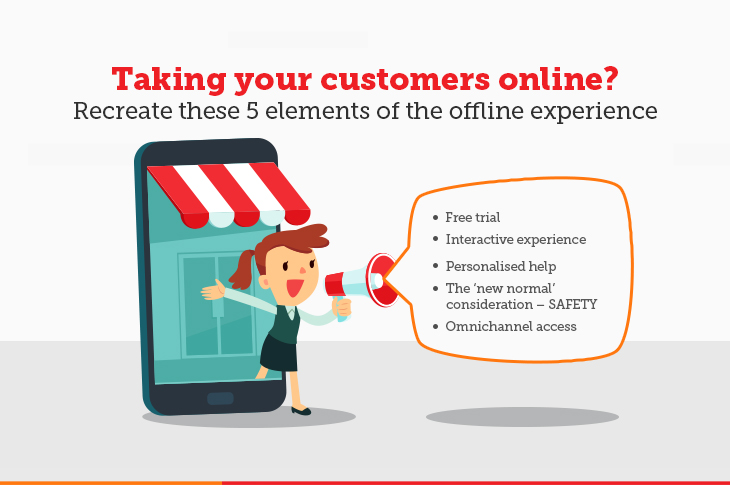How to integrate the appeal of offline stores into your online store

Even as the Indian e-commerce boom pushed revenue from $39 billion in 2017 to $120 billion1 in 2020, there is a large section of shoppers who prefer offline shopping to the online experience. The new wave of shoppers going online in a post-pandemic world aren’t as savvy as those who were using it all along. We all know at least some people who are concerned about payment safety in online transactions. Then there are shoppers who like to pick up the stuff and be assured of the touch-and-feel factor before buying.
If you are looking to seamlessly transition your retail store to the digital mode, these are the elements of the offline experience you should seek to recreate online.
1. Free trial
At your nearby store in a mall or shopping district, you can try out the product or ask for a demonstration, be it test riding a bicycle or trying on a dress (sometimes in the aisle itself) or buying a security software. There will be a salesperson to answer your queries and offer suggestions. Technology can replicate this experience.
Real-time customization in your website can come in handy for customers to virtually try out your products to their satisfaction. This could be as simple as allowing customers to see your vehicles in different colors at the click of a button. For instance, Lenskart introduced the 3D virtual trial of its spectacle frames, which became a huge hit with customers and was highlighted in their video marketing content as a brand USP.
2. Personalised help
Having access to product brochures or product videos is one thing. But the salesperson would also be present to answer any specific questions that customers may have. Most importantly – the additional questions and assurances that make customers feel at ease. Not just “What’s the price of this?” but “Oh, so this is made of linen. That’s not too rough on the skin, is it?”
Advancements in technology have totally changed how effective chatbots are. They can now understand words despite incorrect spellings/typos; they can now understand different languages and dialects; they can now provide information in the form of documents and live links. Chatbots and voice-enabled assistants use NLP (neurolinguistic programming) to give a personal touch to the tech-driven online shopping experience. These
solutions go beyond product descriptions and reviews to give real-time feedback and solutions to interested customers. And they are the key to having human-like conversations with your online customers, even when it’s beyond work hours.
Importantly, chatbots can not only help solve problems but aid purchase-decision making. Two out of five shoppers leave an online platform after getting spoilt for choice. This explains why online platforms are using digital assistants to service customers. While content marketing ensures inflow of traffic, it is digital innovation that can help greatly in retaining the customers.
3. Interactive experience
The whole point of immersive technology is to replicate the 360-degree physical experience of an offline store in a simulated form. Augmented Reality (AR) and Virtual Reality (VR) gives you a near-physical experience of walking around the shelves of a retail store – the way KIA has done. Including 3D contextual content as a part of your video content marketing strategy greatly increases engagement and sales. A Wyzowl survey reported that 95% of video marketers agree that video content improves user understanding. From Facebook 3D posts to 360-degree product videos, augmented reality and other interactive technologies have opened up a new shopping experience for fashion labels like Michael Kors and smartphone brands like Apple, among others.
4. Omnichannel access
If your customer buys a product from a store and it turns out to be faulty, all they need to do is call back the store and complain. That store, and the salesmen at the store, become their one point of contact for all further communication. Be it good or bad, there is always someone accountable.
How do you replicate this singularity and ease online? If your customer can buy a product on your website or app and pick it up from one of your physical stores, can they request for an exchange or refund on your app or elsewhere? Omnichannel integrates content marketing, advertising, sales, and customer service into a seamless experience, irrespective of the channel on which the customer reaches out to you. This ensures that no matter where the customer interacts or transacts with you (social media, website, app, e-commerce platform, retail store, etc.), they can experience the same look and feel and sound that is unique to your brand.
Online furniture store Pepperfry opened up physical studios to spread out to the offline space. Pepperfry uses the physical and online platforms to mutually enhance the shopping experience, irrespective of which platform the customer eventually uses to make the purchase. Omnichannel presence removes the possibility of friction among different sales platforms and instead ensures they are interconnected. For your content marketing campaigns, such successful omnichannel endeavours become a subject of case studies, text posts, and reports.
5. The ‘new normal’ consideration – SAFETY
Understanding the importance of SafeX (safe experience) is paramount in both online and offline shopping. DLF Malls introduced a shop safe application which uses technology to ensure visitor safety in its malls. It provides information on mall traffic inflow, safety updates, prebooking of mall visits, and even an immersive digital wardrobe experience. Given the increased importance on safety, you can highlight these efforts in your emailers and audio/video posts to restore shopper confidence.
Technology, strategy, and efficient content marketing are all important components in a successful online platform. They can smoothen your customers’ transition from the offline store to your online platform.ṭr̥
Sources:
1. https://zoovu.com/blog/bringing-offline-retail-experiences-online/
2. https://www.mckinsey.com/industries/retail/our-insights/adapting-to-the-next-normal-in-retail-the-customer-experience-imperative#
3. https://www.indiaretailing.com/2020/10/22/retail/contactless-a-must-have-for-the-future/
4.https://scatter.co.in/auto-business-online-in-the-times-of-covid/
Contributors to this blog post – Arundhati Dey and Swapnil Adsul
